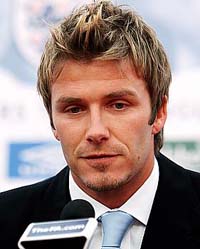Beckham's arrival to LA creates furore
David Beckham is nothing like Pele. And the American landscape is nothing like it was three decades ago when Brazil's World Cup hero arrived in an all but soccer-void United States.

That's the feeling of those who brought the "Black Pearl" to the New York Cosmos in 1975, at least.
"There are many more differences than similarities," said former Cosmos general manager Clive Toye, now a consultant to CONCACAF. "Beckham is the best known player on the planet. Pele was the best known but also the best.
"Beckham arrives when the game is firmly established at all levels and flourishing. Pele arrived into a barren land with the task of building the game, which he, and the NASL, did so well that the Galaxy can now afford an obscene amount of money for a midfield player."
Last week's announcement that the former England captain will transfer to the Galaxy, one of Major League Soccer's two Los Angeles-based teams, later this year in a five-year deal worth a total of US$250 million including endorsements has Toye and some of his contemporaries reminiscing about the courting of Pele and the impact that arrival had on American soccer and sports.
"It's a totally different world," said Jim Trecker, the Cosmos public relations director. "The signings though are equally dramatic. Who could've been signed in 1975? It was Pele. Now to break through all the noise and make a splash, it's Beckham. They're similar moves; very dramatic."
But with several cable television channels dedicated to soccer alone, the American public's awareness of the sport is incalculably ahead of where it was 32 years ago.
"If you look at an old NASL game program, you'll notice a substantial number of pages devoted to explaining the game," Trecker said. "We don't do that anymore."
It took more than four years for Toye, a British native, to lure Pele to the United States. The effort was so secretive, the Cosmos used the code name "Big Crocodile" to refer to Pele according to Toye's recently published book on his time in the North American Soccer League, "A Kick In The Grass."
Beckham's path to the United States has been publicly speculated about for years, with MLS in November finally adopting its Designated Player Rule dubbed by reporters and commentators as "The Beckham Rule" to enable clubs to acquire high-profile international players.
With more than half of MLS' 13 teams set to play this season in stadiums built specifically for soccer, the contrast is stark with the day when Pele played his first game in the United States at the 1930's era Downing Stadium on New York City's Randall's Island on a field that had to be painted green because it was mostly mud.
It parallels other early struggles the NASL faced, such as arguing with television executives to not stop the games for commercials.
"I think (Pele) did have a bigger challenge, 30 years ago," said Jay Emmett, who at the time was the president of Warner Communications, the owner of the Cosmos. "Compare the times. Soccer, nobody knew much about soccer (in the United States). Today, because of Pele, it is known."
Pele's arrival saw the NASL surge from 15 teams the year before his arrival to 24 by 1978, the year after his final season.
International stars such as fellow Brazilian Carlos Alberto, Germany's Franz Beckenbauer, Johan Cruyff of the Netherlands and Peru's Teofilo "Nene" Cubillas all followed Pele to America, which saw the league draw crowds of more than 70,000 and had some respected American commentators predicting soccer would be the biggest sport in America.
But the league's losses mounted, by 1983 it was reduced to 12 teams and it would play its final season a year later.
Despite its folding, the NASL's legacy and ultimately that of Pele, was the inspiration of a youth movement that Toye credits with enabling a bunch of American college kids to qualify the U.S. for the 1990 World Cup its first in 40 years. The United States has qualified for every World Cup since.
By 1994, the World Cup was played in the United States, drawing a record 3.6 million spectators, MLS started two years later and the U.S. team reached the World Cup quarterfinals in 2002 in South Korea and Japan, reports AP.
"MLS has done wonderful job, in many business senses: They had the World Cup television rights, they've been attracting raft of quality sponsors, they've built things we dreamed about stadiums," Toye said.
"They've also done good job developing American players, who for economic circumstances have buggered off to Europe and left MLS without a spark. Beckham doesn't provide a spark, he provides an explosion."
Subscribe to Pravda.Ru Telegram channel, Facebook, RSS!


